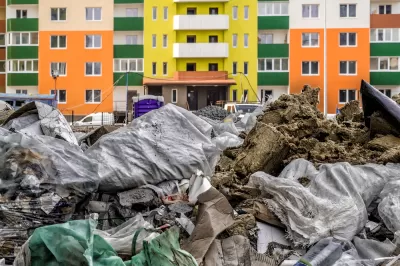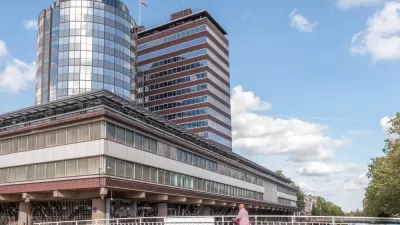Programs that make folks pay for garbage services based on how much they throw away can cut down trash in landfills. Designers are looking for ways to adapt these programs to multiunit buildings.

Policy makers looking to curb waste have had some success with "pay-as-you-throw" schemes, which charge families different amounts for their trash service based on how much waste they produce. One such program in Boulder, Colorado was shown to cut waste to landfills by more than 30%. Now designers are looking to adapt this type of program to multi-unit buildings where it can be much more tricky to tell who is throwing away what and the tragedy of the commons can take hold.
"We think a combination of the right incentives and, yes, trash chute innovations can enable pay-as-you-throw to take hold in apartment buildings — and, over time, improve landfill diversion and recycling rates in cities," Jesse Shapins writes in a Medium post on behalf of Side Walk Talk. In designing for an apartment building, the team had a series of unique challenges to work through, they needed to make something that would identify what apartment was throwing away what garbage without making the residents feel as if their privacy was being invaded.
To test the system, the team created a pilot group and, while they didn't charge the test subjects based on what they threw out, they did apply nudges. "The ultimate goal of a pay-as-you-throw program is to increase recycling rates. In this prototype, we didn’t introduce payment as an incentive, and instead tested simpler behavioral nudges of showing people how much trash they threw away in comparison with neighbors," Shapins writes. The groups tests are not over and the team hopes to continue to scale up to a full building. "We remain focused on the fundamental first step: making trash individually measurable within a multi-family setting," Shapins says.
FULL STORY: We held a one-week design sprint to build a smart trash chute. Here’s what we learned

Planetizen Federal Action Tracker
A weekly monitor of how Trump’s orders and actions are impacting planners and planning in America.

Congressman Proposes Bill to Rename DC Metro “Trump Train”
The Make Autorail Great Again Act would withhold federal funding to the system until the Washington Metropolitan Area Transit Authority (WMATA), rebrands as the Washington Metropolitan Authority for Greater Access (WMAGA).

The Simple Legislative Tool Transforming Vacant Downtowns
In California, Michigan and Georgia, an easy win is bringing dollars — and delight — back to city centers.

The States Losing Rural Delivery Rooms at an Alarming Pace
In some states, as few as 9% of rural hospitals still deliver babies. As a result, rising pre-term births, no adequate pre-term care and "harrowing" close calls are a growing reality.

The Small South Asian Republic Going all in on EVs
Thanks to one simple policy change less than five years ago, 65% of new cars in this Himalayan country are now electric.

DC Backpedals on Bike Lane Protection, Swaps Barriers for Paint
Citing aesthetic concerns, the city is removing the concrete barriers and flexposts that once separated Arizona Avenue cyclists from motor vehicles.
Urban Design for Planners 1: Software Tools
This six-course series explores essential urban design concepts using open source software and equips planners with the tools they need to participate fully in the urban design process.
Planning for Universal Design
Learn the tools for implementing Universal Design in planning regulations.
Smith Gee Studio
City of Charlotte
City of Camden Redevelopment Agency
City of Astoria
Transportation Research & Education Center (TREC) at Portland State University
US High Speed Rail Association
City of Camden Redevelopment Agency
Municipality of Princeton (NJ)





























